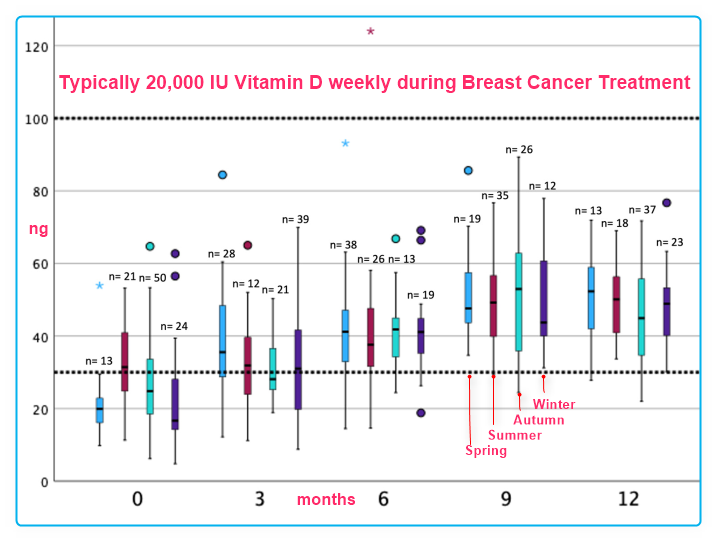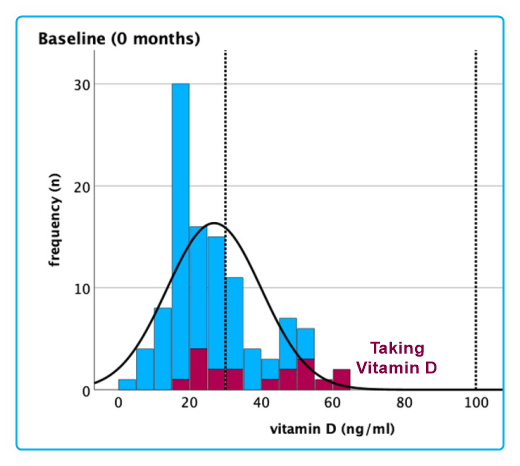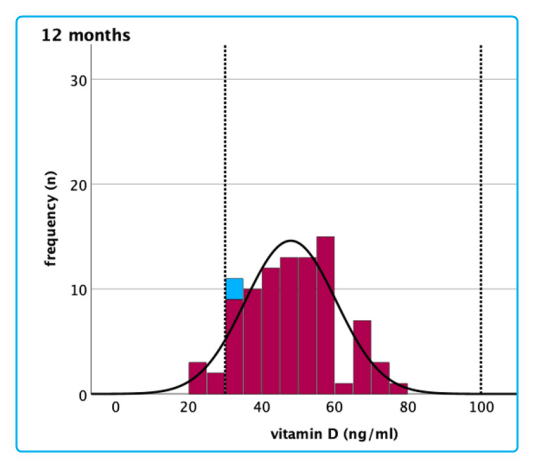Vitamin D needed to treat Breast Cancer varied by 70X
Personalized Vitamin D dosing ranged from 2,000 IU to 140,000 weekly for Breast Cancer:
- A range of 70 to 1
Treating healthy people typically requires a range of Vitamin D of only 4 to 1
The women getting Breast Cancer treatment were clearly not uniformly unhealthy
*
The study failed to note improvement in outcomes vs women not getting Vitamin D
- Shorter treatment durations, less chemo used, less recurrence
Course of Vitamin D Levels in Newly Diagnosed Non-Metastatic Breast Cancer Patients over One Year with Quarterly Controls and Substitution
Nutrients. 2024 Mar 15;16(6):854. doi: 10.3390/nu16060854.
Cosima Zemlin 1 2, Laura Altmayer 1, Marina Lang 1, Julia Theresa Schleicher 1, Caroline Stuhlert 1, Carolin Wörmann 1, Laura-Sophie Scherer 1, Ida Clara Thul 1, Lisanne Sophie Spenner 1, Jana Alisa Simon 1, Alina Wind 1, Elisabeth Kaiser 3 4, Regine Weber 3 4, Sybelle Goedicke-Fritz 3 4, Gudrun Wagenpfeil 5, Michael Zemlin 3, Erich-Franz Solomayer 1, Jörg Reichrath 6, Carolin Müller 1 2 7




Apparently they adjusted dosing quarterly (goal of 30 to 100 ng): used 2,000 to 140,000 IU weekly
Background: Vitamin D levels in patients remain inadequately understood, with research yielding inconsistent findings. Breast cancer patients, particularly due to oncological therapies, face an increased risk of osteopenia, which can be exacerbated by a vitamin D deficiency.
Methods: The prospective observational "BEGYN-1" study assessed serum 25(OH D levels at baseline and quarterly thereafter. Clinical, pathological, nutritional, vitamin supplementation, and lifestyle data were recorded.
Results: Before treatment, 68.5% of patients were vitamin D deficient (<30 ng/mL), with 4.6% experiencing severe deficiency (<10 ng/mL). The median baseline 25(OH)D levels were 24 ng/mL (range: 4.8 to 64.7 ng/mL). Throughout the study, the median vitamin D levels increased to 48 ng/mL (range: 22.0 to 76.7 ng/mL). Before diagnosis, 16.7% received vitamin D substitution, and 97.8% received vitamin D substitution throughout the year with a median weekly dose of 20,000 IU. It took at least three quarterly assessments for 95% of patients to reach the normal range. A multiple GEE analysis identified associations between 25(OH)D levels and supplementation, season, age, VLDL, magnesium levels, and endocrine therapy.
Conclusions: Physicians should monitor 25(OH)D levels before, during, and after oncological therapy to prevent vitamin D deficiency and to adjust substitution individually. While variables such as seasons, age, VLDL, magnesium, diet, and oncological interventions affect 25(OH)D levels, supplementation has the greatest impact.
📄 Download the PDF from VitaminDWiki
VitaminDWiki - studies in both categories Breast Cancer and After Cancer Diagnosis
This list is automatically updated
{category}
VitaminDWiki - Vitamin D: not one size, type, form, route for all - Jan 2022
VitaminDWiki - Huge variation in response to vitamin D supplementation – personal vitamin D response index – Dec 2016
VitaminDWiki - Personalized treatment of Vitamin D
VitaminDWiki – Cancer - After diagnosis category contains:
{include}
